When to Replace your Standing Rigging
The working lifespan of your rigging depends on a number of factors which need to be taken into consideration when deciding to replace these most critical pieces of equipment on your boat. This article looks at these factors which include age, workload and physical condition.
Published 2 years ago
Standing rigging is a primary safety concern
I heard this once from an experienced skipper on the eve of a transatlantic crossing and it has stayed with me:
“The most important safety aspects of sailing offshore are the integrity of the hull and the welfare of the crew.”
But only a little behind those two in fundamental importance will be keeping the standing rigging intact and the mast upright, as those who have been dis-masted will readily testify.
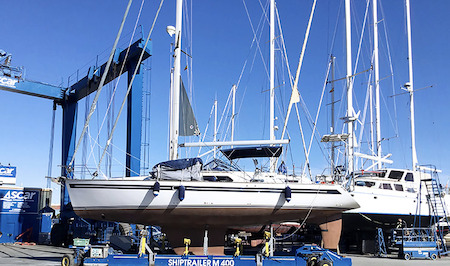

So, how do you decide when to replace your standing rigging?
You will need to consider the age of the rigging, the workload, the physical condition and the external factors outside your control.
Let us take the point about external factors first:
Marine Surveyors and Insurance Companies
The whole question may be academic if your standing rigging is subject to specific conditions in your insurance policy. Insurance companies may request a Marine Survey, including a professional rigging inspection where the last recorded replacement is over a certain age, or insist on a complete wire re-rig. We live in an era of adherence to risk assessments and control policies, so, in all probability, you may have to show proof of regular professional inspections.
However, there is a large variation in the replacement stipulation across the insurance market. A quick internet search reveals examples of 7-10 years, 10-15 years, and even some instances without age mentioned at all, so it may pay to shop around.
There may also be extra conditions imposed according to the predicted nautical mileage. Please note that you should declare any ocean passages to avoid any issues in case of a claim.
If you are seeking new insurance because, for example, you have let your existing policy lapse or you are buying a second-hand yacht, certification or replacement may be a precondition.
This highlights the importance of keeping all the documentation when commissioning a re-rig. Obviously, this should include the date.
For the same reason, when buying or selling a second-hand yacht, a satisfactory provenance on all the major equipment will enhance the chances of a successful outcome.
Then, assuming that you are not restrained by the requirements of a third party, e.g. an insurer, marine surveyor, professional rigger, or potential buyer, we can move on to the considerations that contribute to your decision on judging the right time to renew your rigging.
Standing Rigging Lifespan
The working lifespan of your wire rigging depends on several factors:
Age of the Rigging
Regardless of any external pressure from insurance providers, one consideration should be how long the mast has been stepped and rigged. The decision on how many years is subjective, but is generally acknowledged as being from 10 to 15 years.
Sailing Frequency and Prevailing Conditions
Strong winds and heavy seas take their toll on the standing rigging – the extra strain caused by the combination of wind force and repetitive pounding over waves, especially evident upwind, will cause more stress on every component of the rig. That old maxim, “Gentlemen only sail downwind,” does not just apply to the comfort of the crew, but also to the working life of the wire and the terminals.
More frequent sailing will lead to more metal fatigue. Big breezes and waves exacerbate the process. Even when a yacht is not sailing, the metal fatigue will progress if the mast is stepped, albeit with a reduced load cycle, especially if the shrouds are loose and able to flex. The cyclical loading and unloading of windward and leeward shrouds gradually leads to the development of microscopic cracks not visible to the naked eye. Rig tuning to keep the shrouds and stays at the optimum tension is integral to minimising the detrimental effect, so regular tuning checks are advisable to prevent unnecessary stress.
There is a significant difference in working life expectancy when you compare occasional inshore or coastal sailing in predictably fine weather with extended ocean passage-making, when even the best-prepared voyage plans are subject to severe increases in wind strength and consequential sea state.
Yacht and Rig Design
Check with the manufacturer or designer whether the wire specification on your yacht is the minimum recommended for your yacht length, displacement and sail area or, on the other hand, over-specified in a “belt and braces” approach. A pair of callipers is an essential onboard tool for measuring wire, pin, and hole diameters. No information you glean from outside sources will help unless you can accurately measure your existing rigging for comparison with any recommendations.
An over-specified rig should extend the working life and reduce the risk of failure. Unfortunately, this will come at a price. Wire diameters normally increase in increments of 1mm up to 8mm and 2mm thereafter, and each step up will increase the upfront cost.
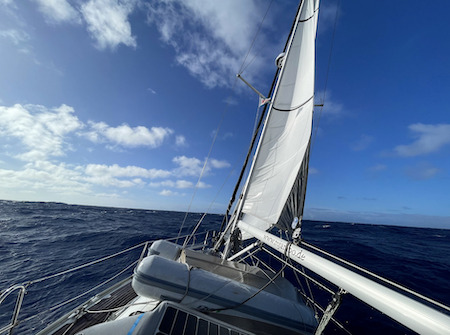

Racing or Cruising?
Stiff rigs and high-powered control systems sustain the desired sail shape and maximise airflow efficiency for pushing hard during regattas and offshore racing, but the more forgiving approach in cruising tends to lessen the demands on the rig and on the crew.
Overall, racing will put greater strain on everything and everyone aboard your yacht, not least the rig.
Rigging Alterations
Has the rigging been altered from the original recommended design? Check carefully for misalignment or odd-looking angles, which may lead to undue stress on the wire or the fitting. Are all the terminals and toggles fitted correctly with sufficient articulation to cope with lateral movement?
For example:
- T terminals that are not seated properly in their mast plate
- T terminals that do not match their mast plate
- Fittings that allow unnecessary movement
- Lack of articulation due to missing toggles
- Undersized clevis pins or oversized clevis pin holes
- Correct routing for each wire
- Symmetry, port and starboard
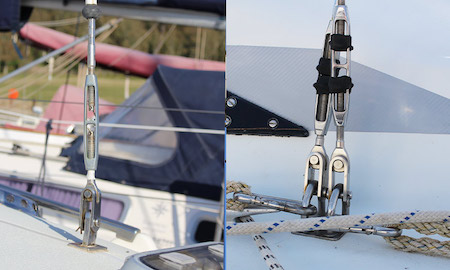

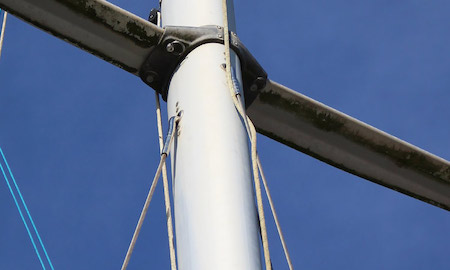

Wire and Terminal Quality
There really is no sense in compromising on quality. Rust is the enemy. The best grade of stainless steel wire and terminals will deliver the best corrosion and metal fatigue resistance and so prolong the working life of your rigging. If you are buying a used yacht, ask for the rigging provenance. If you commission a rerig on your yacht, go for a recognised, trusted brand and a reputable rigging team. And do not forget to keep all the documentation.
Standing Rigging Condition
There is another aspect to consider in judging the right time to renew. Considering all the earlier pointers, how does the existing condition of the rig stack up, and how can you tell?
What are you checking for?
You are looking for anything that does not look or feel right. Here are some examples:
- Broken Strands – are all the strands intact? The first signs normally appear at the point of entry into a terminal. One lifted strand is a strong warning to replace the stay.
- Constructional Deformity – Is the lay uniform with no kinks? You can use your hands to detect any unusual deformation. Any lumps or bumps may indicate a defective internal strand, even if it is not visible.
- Corrosion, Discoloration and Staining – the first signs of rust. Staining is drawn down to the deck by gravity, so home in on contact points between the wire and fittings, such as the spreaders and bottom-end terminals, and scrutinise anywhere with tape that may be holding a contaminant against the wire.
- Pitting – Seawater spray contains chloride, which is a prevalent cause of pitting on stainless steel.
- Hairline Cracks and any other signs of Metal Fatigue – use a magnifying glass or a smartphone camera to zoom in and take a photo for reference and evidence.
- Worn pins and their corresponding holes – The bearing surfaces between the pin and its eye are subjected to all the cyclic micro-movements of the rig. Undersized pins (in diameter) create a point load on the bearing surface of a larger hole. Any long-term detrimental effect is exacerbated when the two are not suitably matched with a tight fit.
- Missing clevis rings and cotter pins – Check that the correct rings and pins are in place. Missing cotter pins are an accident waiting to happen, probably at the worst possible moment. Ensure that all clevis pins are long enough to ensure that the security pinhole is accessible.
- Pin security – Taping is excellent for preventing pins and fittings from snagging on sheets and other loose lines. However, tape should not be relied on to keep a pin in place. Tape may also trap moisture and contaminants, which can accelerate corrosion.
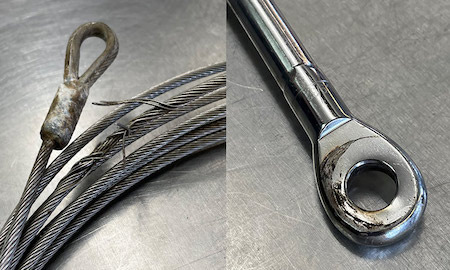

How do you carry out a rigging check?
With your eyes, preferably with a magnifying glass or a smartphone camera, and your hands, by feeling for any abnormality.
Where should you check?
Everywhere accessible during the inspection, including the mast and spreaders, but most importantly, the lower end of the wires, especially where they enter the terminals. The height and linear aspect of the stays means that salt and other corrosive impurities will gravitate to the bottom of the rig.
Salinity and Contaminants
Stainless Steel will deteriorate faster in areas where the sea is warmer and has a higher salt content. There are other significant environmental factors, too. Pollutants and contaminants will have a corrosive effect. Harmful impurities can be wind-borne as well.
Rinsing and Cleaning
Anyone who has seen dark brown rigs from wind-blown sand will appreciate rinsing the standing rigging with fresh water regularly will prove extremely beneficial in the long term. All the stains and discolouration can be removed from stainless steel with a readily available special cleaner. ‘Super Stainless’ is an excellent example because it is easy to apply and rinse with fresh water, leaving a spotless finish. There is an added benefit because straight after cleaning should be the best time to examine the stainless for any visible signs of corrosion or fatigue.
Rigging Inspections
Leaving aside dye and NDT (non-destructive testing), there are three main levels of naked-eye inspection: Skippers Check, Pre-Cruise Check, and Mast Down.
1. Skippers’ Checks
These are regular deck-level checks, which could be as frequent as every day or every time the skipper is on watch for offshore and ocean sailing, especially in severe weather.
2. Pre-Cruise Check
This check should be carried out before any extended passage. It involves sending someone up the mast in a bosun’s chair to visually check everything physically accessible.
3. Mast Down
This is the most thorough method because you have access to every part of the mast and rig, every nook and cranny, with the capability of easily removing and checking all the components for signs of wear and tear. Having the mast horizontal and supported at an ergonomic working height should facilitate inch-by-inch scrutiny by running your hands over every strand and naked eye examination of every integral component, especially with the aid of a magnifying glass or the zoom facility on a smartphone camera.
You should seek out any signs of potential premature failure with a critical eye because any part replaced in good time could prolong the safe working life of the entire rig. It has often been found that a dis-masting disaster can be traced back to one critical defect. Opinion varies on the frequency of these inspections. Still, every three years seems very sensible, or immediately before a trans-ocean passage if you are planning that voyage before the next scheduled Mast Down check.
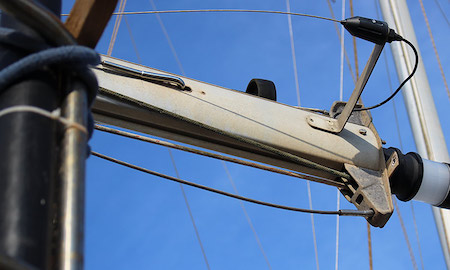

Conclusion
- There is no simple formula. The safe working lifespan of standing rigging will vary enormously according to quality, design characteristics and workload (cyclical loading).
- Thorough and regular scrutiny may alert you to premature failure of an individual component.
- Meticulous attention to optimum rig design (alignment and compatibility) and frequent rig tuning will reap dividends in terms of prolonging the working life of the rigging.
- Metal fatigue is inevitable and may be invisible.
- Respond to outside influences such as Marine Surveyors, Professional Riggers, and Insurers.
- Consider the sailing you are planning.
- If in doubt, bite the bullet and tackle the job.
…………………………
About the Author
Jimmy Green Marine is a family-run business founded by brothers Alistair and Mike Green, based in the coastal fishing village of Beer in East Devon. The company started as a Mail Order Chandlers in 1981 and has continually evolved from attending Boat Shows and Boat Jumbles in the early days to now trading globally online.

Four decades of exporting experience combined with an intuitive website shipping calculator means that you can have your order delivered to your home, business or direct to your yacht anywhere worldwide.
Their flagship, innovative Custom Build website system provides an instant quote for all your professionally spliced and finished wire and rope rigging, mooring and anchoring solutions.
You can access this online from wherever you can get an internet connection, however remote.
Alistair Green is an experienced sailor and rigger with over 40 years of experience in the marine industry. He is passionate about providing his customers with the best possible products and services and is always looking for new ways to improve the business.
If you are looking for a reliable and experienced marine supplier, then Jimmy Green Marine is the perfect choice.
Visit their website today to learn more about their products and services.
…………………………
Related Links:
- About Jimmy Green Marine
- Custom Splicing, Rigging and Sewing Service
- Worldwide Shipping
- Jimmy Green Marine joins Noonsite.com as Official Ropes and Rigging Partner (April 2023)
Other Articles by Jimmy Green Marine:
- Ten Reasons to Whip and Stitch Your Ropes (September 2023)
- How to Choose your Next Anchor Chain (August 2023)
- How to Choose a New Halyard (July 2023)
- The Uses and Benefits of Rope Splicing Onboard a Yacht (May 2023)
………………………………
The opinions expressed in this article are the author’s own and do not reflect the view of Noonsite.com or World Cruising Club.
………………………………
Find out all news, reports, links and comments posted on Noonsite, plus cruising information from around the world, by subscribing to our FREE monthly newsletter. Go to https://www.noonsite.com/newsletter/.
Related to the following Cruising Resources: Books, Cruising Information, Equipment, General, General Services, Global Yachting Services, Passage Planning, Planning and Preparation, Sails & Rigging

